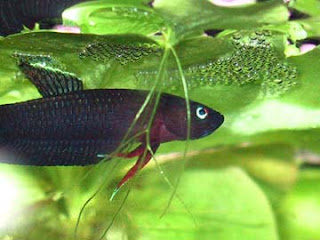Causes and symptoms of fish TB.
Mycobacterium marinum. Possible treatment. There is some danger to humans when servicing
Tuberculosis was once a dreaded disease in Europe as well as North America and virtually everyone knew someone who had succumbed to ‘consumption’, the commonly used name for the disease caused by Mycobacterium tuberculosis. Tuberculosis is still widespread in most third world countries and after the fall of the Soviet Union, the numbers of tuberculosis patients have sky rocketed in Russia as well as in many other post-soviet states.
What few of us know, however, is that a bacterium closely related to Mycobacterium tuberculosis called Mycobacterium marinum can be present in wild caught as well as captive bred fish and stay lurking in our aquariums without us ever realizing it. After all, when one of our fishes goes belly up, few of us drag out the Petri dish and starts growing bacterial cultures to find out exactly what caused its demise.
Since Mycobacterium marinum is so closely related to Mycobacterium tuberculosis, the disease it causes is commonly referred to as fish tuberculosis of fish TB. Learning more about fish tuberculosis is recommended for all aquarists since it can be lethal to our beloved fish. What’s even worse, Mycobacterium marinum can spread to the aquarist and cause serious health problems. It can also spread to other animals and is capable of surviving in both soil and water without any host for prolonged periods of time. Don’t be fooled by the word “marinum” – this nasty little organism will survive just as well in freshwater conditions.
Susceptibility Certain types of fish seem to be more at risk of carrying, or at least succumbing to, fish tuberculosis. This group includes the labyrinth fishes, among which you will find many popular aquarium fishes such as Bettas and Gouramis.
Symptoms in fish The main symptoms of fish tuberculosis are loss of scales, loss of color, lesions on the body, wasting, and skeletal deformities such as curved spines.
Diagnosing Looking a slides of infected tissue under a microscope is sometimes enough to recognize Mycobacterium marinum, but in most cases a bacterial culture will be necessary. BothMycobacterium tuberculosis and Mycobacterium marinum are acid fast, which means that they stain bright pink against a blue background.
Treatment Treating fish tuberculosis is really difficult and euthanizing the fish a probably less painful for the fish than forcing it to go through endless treatments that may not have any effect on the disease. Euthanizing all the fish in the infected aquarium is also the best way of preventing the disease from spreading.
If you decide to try and treat your fish, keep in mind that Mycobacterium marinum can infect you as well. The risk of being infected can however be decreased dramatically by following a few simple safety guidelines. You can read more about this further down in this article.
Fish can be treated with the same drugs as humans get when they become infected by Mycobacterium marinum, e.g. Kanamycin. Since this is a very resilient microbe, normal treatment involves administering at least two different medications over the course of at least three months.
A lot of aquarium problems can be fixed by performing frequent water changes, increasing the water temperature and adding some salt to the water, but fish tuberculosis is not one of them. Raising the water temperature may even worsen the problem since Mycobacterium marinum prefers warm water (their ideal temperature is 30°C).
Prevention Since curing fish is virtually impossible once the disease begins to manifest, preventative measures are highly important.
Keeping your fish healthy, happy and well-fed will boost their immune system and make it possible for them to handle limited exposure to Mycobacterium marinum.
Wounded or otherwise weakened fish should be moved to quarantine tanks where they can be treated and given time to recuperate, since weak fish that is left in the main aquarium can serve as a breeding ground for all sorts of malicious microorganisms that may eventually grow numerous enough to attack even the healthy fishes.
New fish should ideally be quarantined before you allow it into you main aquarium. Plants, substrate, equipment etcetera should be sterilized to kill of potentially harmful bacteria before being introduced to the aquarium. See the plant section for more info about how to sterilize plants without causing injury to them.
An aquarium that has had an outbreak of fish tuberculosis should be meticulously cleaned out wh bleach and left to dry before you restock it.
Prevention When aquarists become infected by Mycobacterium marinum, it is usually because the carry out maintenance work when they have cuts or other skin problems on their hands or arms. Our skin is remarkably good at keeping malevolent microorganisms out, but as soon as the skin gets injured, an important part of the body’s defense system has been breached. It doesn’t have to bee a large wound; a simple paper cut or eczema can be enough for Mycobacterium marinum to slip through. When handling an aquarium where you suspect thatMycobacterium marinum may be present, it is consequently important to use protective gloves. You may have a tiny sore that you haven’t even noticed, such as a torn cuticle. Some aquarists prefer to use gloves all the time, or at least when they have damaged skin, since it is impossible to know if Mycobacterium marinum exists in an aquarium before the fish start to show symptoms of fish tuberculosis. You can also catch fish tuberculosis by using your mouth to start a siphon. Washing your hands and lower arms with soap after handling fish and aquariums is naturally always recommended.
Symptoms and treatment When aquarists become infected with fish tuberculosis, it normally starts as a skin problem. Mycobacterium marinum is a slow growing mycobacterium and it can therefore take several weeks before you notice any symptoms. The first sign is normally small purple lesions or “bumps”. The lesions will grow and spread and Mycobacterium marinum can proceed to destroy the soft tissue under the skin, including tendons and joints. In severe cases, fish tuberculosis can spread to the bones and cause symptoms similar to arthritis.
Most doctors never come in contact with fish tuberculosis and if you show up with some strange lesions on your hands, they might not realize what is causing it and put you on a general oral antibiotic that will not kill Mycobacterium marinum. It is therefore very important to inform your doctor that you are an aquarist and that you may have caught fish tuberculosis or some other disease from your aquarium. Mycobacterium marinum can be successfully treated but only if the right combination of drugs are used. Just as with Mycobacterium tuberculosis, the treatment will normally need to be carried out over the course of several months. In serious cases, intravenous administration of antibiotics may be required.
































































